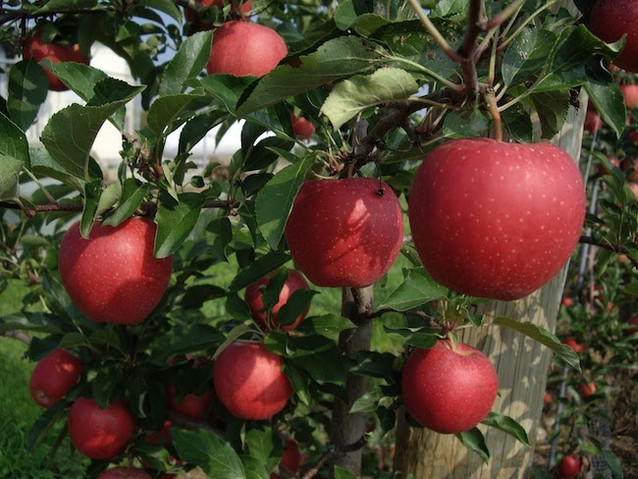Posted by Jeff Pauls on 9th Jun 2020
A Cargo of Apples
Looking forward to this season’s apples? So are we! Although most of our apples are still in their early stages of growth, in just a month or so, Yellow Transparent apples will be available in our store and online. As the Yellow Transparent apple link reveals, the history of apples is more than most of us realize, and we’re very fortunate to have access to fresh, local produce. Believe it or not, boats and waterways have played a key role in making this mere possibility a reality.
Whether we realize it or not, we are indebted to the maritime industry for the lifestyle we enjoy today. An example of these benefits is our almost unlimited access to such a wide variety of food. As part of the transportation infrastructure, the maritime industry still plays a large role in transporting food to countries all over the world. (GO MARITIME, Go Shipping)
Because of sea going vessels, people groups throughout history have been able to travel to other parts of the world. When Europeans came to what we now call the United States, they brought many things that were new to this area. Among their cargo were apple “seeds and cuttings from Europe, and while the original varieties planted were not all suited for cultivation in the New World, their seeds began to produce all-new varieties of American apples.” (History Channel)
Yes, boats bring food to us, but without advances in technology, our access to that food would be more limited than it is. On 22 May 1819, the American steamship Savannah set sail from Savannah, Georgia. This transoceanic voyage was the first of its kind. Up until this time, no ship had used steam power to make such a voyage, but had relied solely on wind. In 1933, the U.S. Congress declared May 22 as National Maritime day so as to honor and celebrate the Maritime Industry and its many participants throughout history. (Nat’l Maritime Day)
Thus, without commercial ocean travel, we would not have the apples we have today. And as the European population grew and spread inland, they took these seeds and cuttings with them. By 1905, there were approximately 14,000 distinct varieties of apples in the U.S. (A Curious Tale: The Apple in North America)
One notable example of the advantage of transportation was its effect on the distribution of the Newtown Yellow Pippin (a strain of the original Newtown Pippin, which is green.) The Yellow Newtown Pippin has been grown in Virginia since 1755. Upon his return from the French and Indian War, state militia officer, Thomas Walker, brought scion wood of the Newtown Pippin to his home county of Albemarle. He distributed the tree in North Garden, Albemarle County and it is now known as the Albemarle Pippin. (It's Crunch Time for the Venerable Pippin)
“The crisp, juicy, firm flesh and very distinctive taste, along with its excellent keeping qualities, made the Pippin the most prized of American dessert apples from the early 18th century. It grows especially well in the Virginia Piedmont and attracted great notoriety when Andrew Stevenson, the American minister to St. James, presented the young Victoria with a gift basket of the apples in 1838 from his wife's Albemarle County home, Enniscorthy. ‘Never did a barrel of apples obtain so much reputation for the fruits of our country,’ Sallie Coles Stevenson reported. As a gesture of appreciation, Parliament permitted the Virginia apple to enter Britain duty-free, and the Albemarle Pippin became an important export, commanding premium prices in the English market. After World War I, Parliament levied duties again on non-Commonwealth fruit, and the Pippin's market waned.” (Albemarle Pippin)
The story of the Albemarle Pippin is just one of many examples of how ships and other means of transportation played a part in the history of North American apple varieties. And it must be noted, that since particular varieties of apple (Yellow Delicious, Fuji, etc.) do not “naturally” propagate themselves, scions must be physically transported to wherever a grower wants to cultivate them. There must have been a lot of transporting to achieve 14,000 different varieties by 1905!
Even though U.S. commercial apples are only about .07% of what was available in 1905, we can once again discover and taste apples not widely available. Because of information technology (which is closely linked to transport technology), we can track down apples such as the Albemarle Pippin; apples having a long history, featuring unique and explosive flavors. With the advent of the slow/local food movement, more and more of us will experience and enjoy the benefits of “Old World Food” just like England did in the 19th and 20th centuries. Everytime a ship unloaded Albemarle Pippins at an English port, I’m sure the “crisp, juicy, firm flesh and very distinctive taste, along with its excellent keeping qualities,” were enjoyed by many happy customers.
And now, in the year 2020 apple season, we look forward to sharing the bounties of our orchards with you in the very near future. Visit us often throughout the summer to enjoy a taste of each variety of applewe grow.

